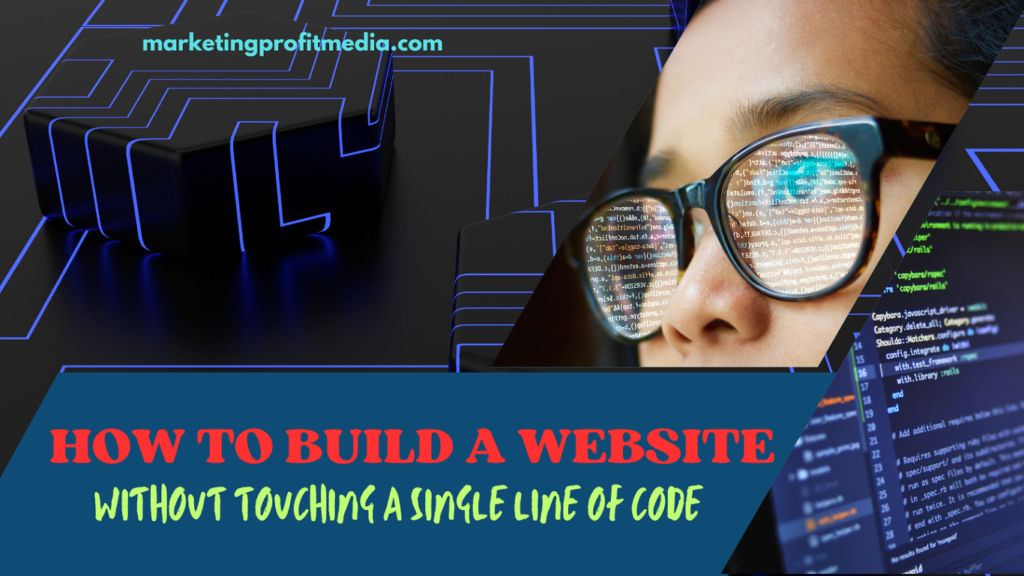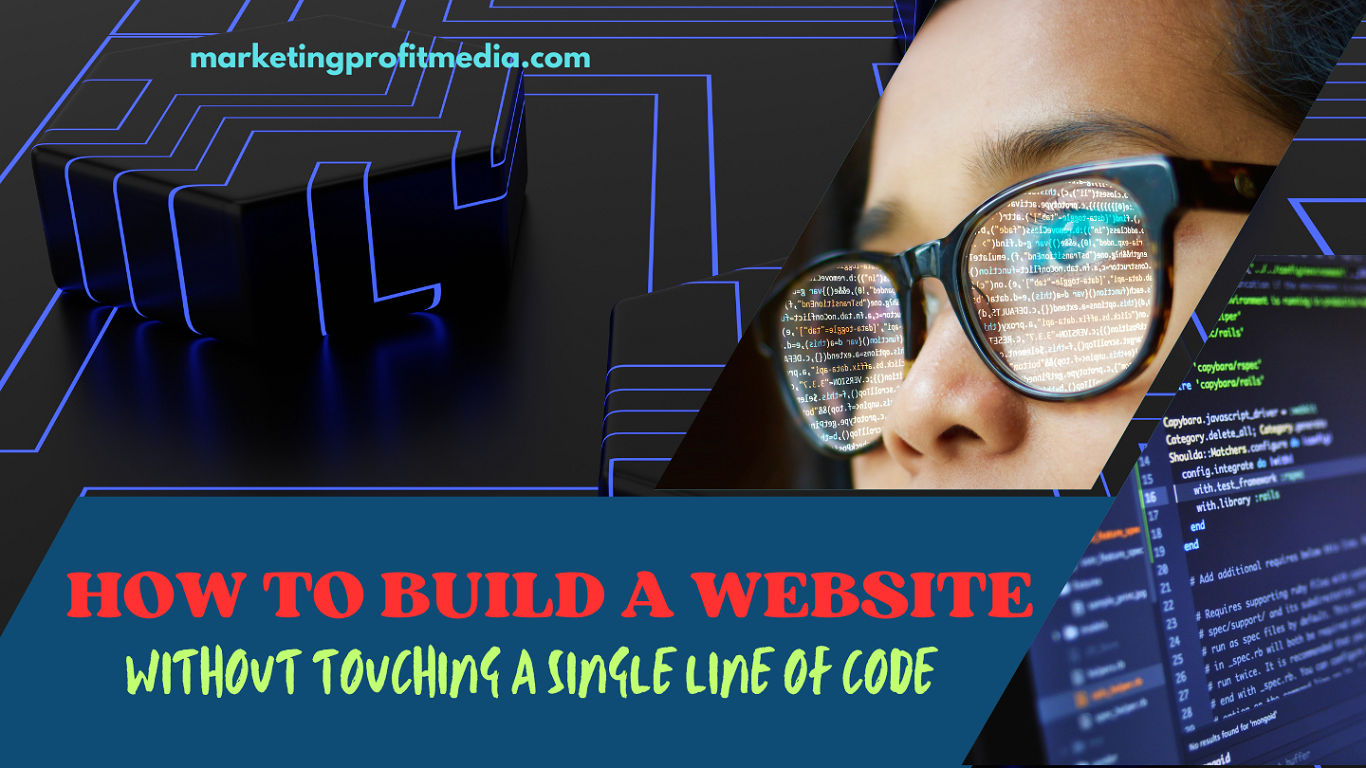Starting a website has never been easier, owing to the growth of no-code and low-code platforms. In a digital age when coding ability was formerly required, anybody with a vision can now create a gorgeous website without diving into the complexities of programming. Join us as we delve into the intriguing world of website construction without coding, learning about user-friendly interfaces, drag-and-drop functionality, and pre-designed themes. Say goodbye to complicated programming and welcome to the ease of creating your online presence. This is the ultimate guide on How to Build a Website Without Touching a Single Line of Code.

My Best Recommended & Proven Way to Make $100 Daily – Watch THIS FREE Training to START >>
The Rise of No-Code/Low-Code Platforms
The digital era has given birth to a new wave of website development – the no-code/low-code movement. These platforms empower users to design, customize, and launch websites without the need for programming skills. Popular options such as Wix, WordPress, and Squarespace have gained immense popularity due to their user-friendly interfaces and powerful features.
Advantages of Using No-Code/Low-Code Platforms
The allure of no-code platforms lies in their accessibility. Users with diverse backgrounds can leverage these platforms to bring their ideas to life. The advantages include rapid development, cost-effectiveness, and the ability to iterate quickly without being tethered to a coding environment.
Understanding No-Code Tools
No-code tools utilize intuitive interfaces, allowing users to build websites through drag-and-drop mechanisms, pre-designed templates, and seamless integrations with third-party applications. These tools democratize website creation by eliminating the technical barriers that once confined it to the realm of developers.
Drag-and-Drop Interfaces
One of the hallmark features of no-code platforms is the drag-and-drop interface. Users can simply select elements, drag them onto the canvas, and position them according to their preferences. This level of visual control makes website design a creative and enjoyable process.
Pre-Designed Templates
No-code platforms often come equipped with an array of professionally designed templates. Users can choose a template that aligns with their vision and then customize it to suit their brand or personal style. This streamlines the design process and ensures a polished result.
Integrations and Plugins
To enhance functionality, no-code platforms offer integrations and plugins that enable users to incorporate features like e-commerce, social media feeds, and contact forms seamlessly. This flexibility allows for the creation of dynamic and feature-rich websites.
Choosing the Right Platform
Selecting the right no-code platform is crucial for the success of your website. Consider your specific needs, the complexity of your project, and the scalability of the platform you choose. Let’s delve into the factors that should guide your decision-making process.
Assessing Your Website Needs
Before jumping into the world of no-code website development, evaluate your requirements. Are you creating a personal blog, an online portfolio, or an e-commerce site? Different platforms cater to various needs, so understanding yours is the first step.
Comparing Features of Different Platforms
Different no-code platforms offer varied features. While Wix may excel in its drag-and-drop capabilities, WordPress might be favored for its extensive plugin library. Make a list of features that are crucial for your website and compare platforms accordingly.
Considering Scalability and Flexibility
As your website grows, scalability becomes a vital factor. Ensure that the chosen platform can accommodate future expansions and modifications. Flexibility in design and functionality is essential for adapting to changing needs.
My Best Recommended & Proven Way to Make $100 Daily – Watch THIS FREE Training to START >>
Step-by-Step Guide to Building a Website Without Code
Now that you have a grasp of the foundational concepts, let’s embark on a step-by-step journey to build your website without touching a single line of code.
Selecting a No-Code Platform
Begin by choosing a no-code platform that aligns with your goals. Evaluate factors such as ease of use, available templates, and the overall user experience. Wix, for instance, is known for its simplicity, while WordPress offers unparalleled customization.
Setting Up Your Account
Once you’ve chosen a platform, create an account. This typically involves providing basic information, selecting a username, and, in some cases, choosing a subscription plan. Most platforms offer free trials, allowing you to explore their features before committing.
Choosing a Template or Starting From Scratch
No-code platforms often provide a plethora of templates categorized by industry or purpose. Select a template that resonates with your vision. Alternatively, if you prefer to start from scratch, choose a blank canvas and let your creativity flow.
Customizing Your Website
Personalize your chosen template to make it uniquely yours. Modify colors, fonts, and layout elements to match your brand or personal style. Most platforms allow granular customization, ensuring your website reflects your individuality.
Adding Content and Media
Populate your website with compelling content. Whether you’re showcasing your portfolio, writing blog posts, or setting up an online store, use the platform’s intuitive tools to add text, images, and multimedia elements seamlessly.
Integrating Third-Party Tools
Enhance your website’s functionality by integrating third-party tools. If you’re running an e-commerce site, connect payment gateways. For social media integration, link your accounts to keep your audience engaged across platforms.
Testing Your Website
Before going live, thoroughly test your website. Check for responsiveness on different devices, assess loading times, and ensure all interactive elements function correctly. Testing is a crucial step in delivering a seamless user experience.
Publishing Your Website
Once satisfied with your website’s design and functionality, it’s time to publish. Most no-code platforms offer straightforward publishing processes. Follow the prompts to make your website accessible to the world.
Common Challenges and Solutions
While no-code platforms offer a user-friendly experience, challenges may arise. Understanding common issues and their solutions is essential for a smooth website development journey.
Limitations of No-Code Development
No-code platforms have certain limitations, especially when compared to custom-coded websites. Recognize these limitations and choose a platform that aligns with your project’s scope. For highly complex projects, consulting with a developer may be necessary.
Troubleshooting Common Issues
Issues like layout discrepancies, broken links, or slow loading times may occur. Most no-code platforms provide troubleshooting guides or customer support. Leverage these resources to address issues promptly and maintain optimal website performance.
Seeking Help from Community Forums
No-code platforms often have vibrant user communities. Engaging with these communities through forums and discussion boards can provide valuable insights, tips, and solutions to common challenges. Don’t hesitate to seek help from experienced users.
Tips for Optimizing Your Code-Free Website
Building a website without code doesn’t mean compromising on quality. Implementing the following tips will ensure your code-free website stands out and performs well.
SEO Strategies for No-Code Websites
While no-code platforms handle many SEO aspects automatically, optimizing your content for search engines is still crucial. Pay attention to meta tags, image alt text, and keyword placement to improve your website’s visibility.
Ensuring Mobile Responsiveness
Given the prevalence of mobile users, ensure your website is responsive on various devices. No-code platforms typically prioritize mobile responsiveness, but it’s essential to double-check and make adjustments if needed.
Regularly Updating Content
Frequent content updates not only keep your audience engaged but also signal to search engines that your website is active and relevant. Utilize the easy content management features of no-code platforms to regularly refresh your website.
My Best Recommended & Proven Way to Make $100 Daily – Watch THIS FREE Training to START >>
Success Stories
To inspire confidence in code-free website building, let’s explore a few success stories of individuals and businesses that have thrived using no-code platforms.
Real-World Examples of Websites Built Without Code
- Personal Blog: John’s Journeys John, an avid traveler, used Wix to create a stunning blog showcasing his adventures. The drag-and-drop features allowed him to highlight his travel experiences with captivating visuals.
- Online Store: Handmade Haven Handmade Haven, an e-commerce site built on Shopify, showcases unique handmade products. The platform’s simplicity enabled the store owner to manage inventory, process orders, and offer a seamless shopping experience.
Achievements and Benefits of Using No-Code Platforms
No-code platforms have empowered individuals and businesses in various ways. The flexibility, affordability, and ease of use contribute to their success. Whether it’s launching a personal brand or establishing an online store, the benefits are tangible.
Future Trends in No-Code Development
The landscape of no-code development is continually evolving. As technology advances, so do the features and functionalities of these platforms. Let’s explore some potential future trends in the realm of code-free website building.
Evolving Features and Functionalities
No-code platforms are likely to incorporate more advanced features, providing users with increased creative control and flexibility. Expect to see improved customization options, AI-driven design suggestions, and enhanced collaboration tools.
Integration with Emerging Technologies
The integration of emerging technologies, such as augmented reality (AR) and virtual reality (VR), into no-code platforms could revolutionize website design. This opens up new possibilities for creating immersive and interactive online experiences.
Potential Impact on the Web Development Industry
The growing popularity of no-code platforms could reshape the web development industry. As more individuals and businesses opt for code-free solutions, traditional development practices may see a shift. Developers may find themselves focusing on more complex and specialized projects.
Conclusion
In conclusion, the era of website development being confined to coding experts is behind us. No-code and low-code platforms have democratized the process, allowing anyone with a vision to create a website without touching a single line of code. The accessibility, flexibility, and future potential of these platforms make them an attractive option for individuals and businesses alike.
FAQs
Q. How much does it cost to build a website without code?
The cost of building a website without code varies depending on the platform and features you choose. Many platforms offer free plans with limited features, while premium plans with advanced functionalities may range from $10 to $50 per month.
Q. Can I migrate my existing website to a no-code platform?
Yes, most no-code platforms provide tools or services to help you migrate your existing website. However, the process may involve some manual adjustments to ensure a seamless transition, especially if your current site relies heavily on custom code.
Q. Are no-code websites secure?
No-code platforms prioritize security and often include built-in features to protect your website. However, it’s essential to follow best practices, such as using secure passwords and keeping your platform and plugins up to date, to ensure the security of your no-code website.
Q. Do I need any technical skills to use no-code platforms?
No, that’s the beauty of no-code platforms. They are designed to be user-friendly, allowing individuals without technical skills to create and manage their websites. The intuitive interfaces, drag-and-drop functionality, and pre-designed templates make the process accessible to everyone.
Q. What happens if the no-code platform shuts down?
Most no-code platforms have measures in place to ensure data safety and provide users with the option to export their content. It’s advisable to regularly back up your website and stay informed about the platform’s policies in case of any unforeseen circumstances.
My Best Recommended & Proven Way to Make $100 Daily – Watch THIS FREE Training to START >>
Thanks for reading my article on “How to Build a Website Without Touching a Single Line of Code“, hope it will help!














